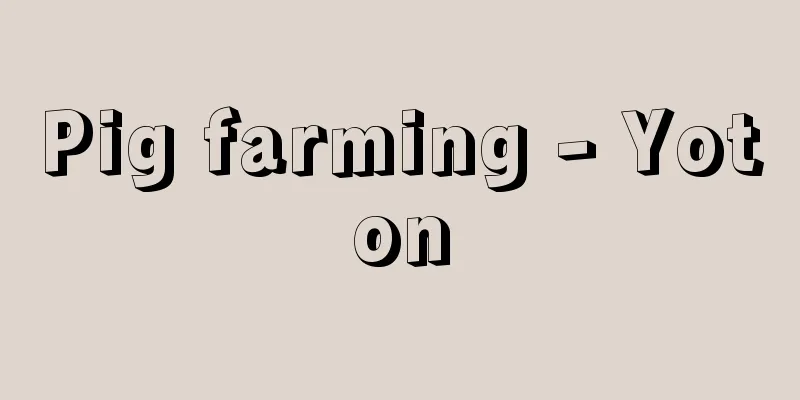Pig farming - Yoton

|
It refers to raising pigs to produce meat and other products. Depending on the type of operation, it is classified into three types: breeding pig operation, breeding pig operation, and fattening pig operation. (1) In breeding pig farming, breeders (stock producers) aim to genetically improve pigs and produce original breed pigs that serve as the basis for breeding and multiplication. They raise registered pure breeds and select them based on the results of performance tests such as progeny tests and offspring tests to improve genetics. Large-scale pig farming requires highly inbred pedigree pigs to effectively utilize heterosis, and this type of farming requires advanced technology and large amounts of capital. (2) Breeding pig farming, also known as piglet raising, is aimed at producing piglets for fattening. The animals raised do not necessarily have to be pure breeds; rather, an increasing number of pig farmers are using hybrid sows with excellent fertility to produce three- or four-way hybrid piglets. The piglets weigh about 20 kilograms and are sold as piglets for fattening. In order to raise a large number of piglets, it is necessary to increase reproductive efficiency, which requires techniques such as identifying the optimal mating period, preventing accidents during parturition, and promoting turnover by early weaning. (3) In the case of fattening pig farming, piglets weighing 20 kilograms are purchased, fattened for about five months until they reach a weight of 90 to 100 kilograms, and then shipped to a slaughterhouse. Compared to the previous two methods, fattening pig farming is more common because it requires less manpower and is easier to raise multiple pigs. In fattening pig farming, the availability of piglets is unstable, so integrated management that covers both breeding and fattening has become the norm. Although integrated management has the difficulty of having to combine the different quality techniques of breeding and fattening, it also has many advantages, such as being able to avoid fluctuations in piglet prices because the piglets are produced in-house, making it easier to create a rational management strategy by planning the production of piglets, there is no need to worry about disease prevention because piglets are not introduced, and it is possible to select and cull breeding pigs based on the performance of fattening pigs. [Yoichi Shoda] Pig farming around the worldThere are approximately 900 million pigs raised in the world, and the areas where pig raising is particularly popular are East Asia, centered around China, parts of Europe such as Denmark, the Netherlands, Belgium, and Germany, and the Corn Belt stretching south of the Great Lakes in the United States, which are known as the world's three largest pig-raising regions. Pigs, livestock animals, inherited an omnivorous diet (they will eat anything) from their wild boar ancestors, and this is utilized in breeding methods, which include both making effective use of feed resources that cannot be used by humans, and purchasing nutritious concentrated feed and feeding it to them, in a processing industry-style manner to efficiently produce meat in a short period of time. Examples of the former are free-range pig farming (montanera), which feeds on acorns from cork oak forests in southern Spain, and pig farming in southern China, which feeds on aquatic plants from creeks, while pig farming in Denmark and Japan is of the latter type. [Yoichi Shoda] Pig farming in JapanIn Japan, remains have been found suggesting that wild boars were already being raised in the Jomon and Yayoi periods. It was not until the Nara period that records of wild boars were clearly recorded, when a position called Ikaibe (boar farmer) was established and boar meat was presented to the Imperial Court. With the introduction of Buddhism, eating meat was banned and pig farming ceased, but pig farming continued as an exception in Okinawa and parts of Kyushu, where Chinese culture was strongly influenced. In the Meiji period, agriculture from advanced Western countries was introduced to Japan, and pig farming resumed, but in 1887 (Meiji 20), there were only about 40,000 pigs. The number of pigs kept gradually increased thereafter, reaching a pre-World War II peak of about 1.14 million in 1938 (Showa 13). At that time, pig farming in Japan was dominated by small-scale farming where one or two pigs were raised as a side job under a small roof on the eaves of a farmhouse. Food was also used for feed, and this was called eaves-front or eaves-front pig farming. Because cane vines and starch residue were important feed sources, pig farming was popular in southern Kyushu and the Kanto region, where cane cultivation is thriving. During World War II and the food shortage that followed, the situation regarding pig feed became the worst, and in 1946 (Showa 21), the number of pigs kept fell to about 88,000, a devastating blow. However, when the situation regarding feed improved in the 1950s, the number of pigs kept rapidly increased, coupled with the increased demand for meat, reaching 11.06 million in 1986. However, pork consumption subsequently plateaued, and the number of pigs kept slightly decreased, to 9.87 million in 1999 (Heisei 11). Meanwhile, despite the increase in the number of pigs being raised, the number of pig farms has been declining since peaking in 1962, to 100,000 in 1986, one-tenth of the peak, and to 12,500 in 1999. The average number of pigs being raised per farm is now 790, and full-time farming is becoming more prevalent. As the scale of operations expands, there have been remarkable advances in facilities and farming techniques, as well as a notable change in the breeds being raised. The Middle Yorkshire, which accounted for 95% of the pigs in Japan until before the Second World War, has disappeared, replaced by pure breeds such as Landrace, Large Yorkshire, Duroc, and Hampshire, and three-way and four-way crossbreeds between these breeds are now widely used to take advantage of hybrid vigor (heterosis) for fattening pigs. Feed is now mainly concentrated feed made from imported grains, and the only by-product use from the past remains in pig farming using leftover food in urban areas. As a result, feed costs account for a high proportion of production costs, and the state of the international grain market has come to determine the state of the pig farming industry. The expansion of the scale of operations has also resulted in the increased importance of measures to prevent infectious diseases, and the prevention of viral infectious diseases such as Aujeszky's disease and infectious respiratory diseases has become a major issue, while the treatment of excrement and wastewater has become a problem in relation to environmental pollution. [Yoichi Shoda] "Pig Farming Masterpiece" by Tatsuo Sasazaki (1988, Yokendou) [References] | | | |Source: Shogakukan Encyclopedia Nipponica About Encyclopedia Nipponica Information | Legend |
|
ブタを飼育して、食肉その他を生産することをいう。その内容によって種豚(しゅとん)経営、繁殖豚経営、肥育豚経営の3種に分類される。 (1)種豚経営は、豚の遺伝的改良を目ざし、育種・増殖の基礎となる原種豚を生産する、いわゆるブリーダー(種畜生産家)である。血統登録された純粋種を飼育し、後代検定や産子検定などの能力検定の成績を参考にして選抜を行って遺伝的改良を図る。大規模な養豚経営では、雑種強勢(ヘテローシス)を有効に利用するため近交度の高い系統豚が要求されており、高度の技術と多額の資本を必要とする経営形態である。 (2)繁殖豚経営は子取りともいい、肥育用の素豚(もとぶた)生産を目的としたものである。飼養する個体はかならずしも純粋種である必要はなく、むしろ繁殖能力の優れた一代雑種の雌豚を用いて、三元雑種や四元雑種の子ブタを生産する養豚家が増えてきている。子ブタは体重20キログラムぐらいで肥育用素豚として売却される。子ブタをたくさん育てるためには繁殖効率を高める必要があり、交配適期の認定、分娩(ぶんべん)時の事故防止、早期離乳による回転促進などの技術が要求される。 (3)肥育豚経営は、体重20キログラムの子ブタを購入し、5か月ほど肥育して体重90~100キログラムに肥育し、と畜場へ出荷する経営形態で、前二者よりも管理に人手を要さず多頭飼育が容易であるため、大規模なものが多い。肥育豚経営においては素豚の入手が不安定であるため、繁殖と肥育を通して行う一貫経営が大多数を占めてきている。一貫経営は繁殖と肥育という質の異なる技術を兼ね備えなければならないという困難性はあるが、一方、素豚を自家生産するため子ブタ価格の変動から逃れられ、子ブタの計画生産により合理的な経営戦略をたてやすい、子ブタの導入がないため防疫上の不安がない、肥育豚の成績をみて繁殖豚の選抜淘汰(とうた)が可能であるなどの有利な点も多い。 [正田陽一] 世界の養豚世界に飼育されているブタは約9億頭で、とくに飼育の盛んな地域は、中国を中心とした東アジアと、デンマーク・オランダ・ベルギー・ドイツといったヨーロッパの一部、アメリカの五大湖の南に広がるコーンベルトで、これを世界三大養豚地帯とよんでいる。 ブタという家畜は、先祖のイノシシから受け継いだ広食性(なんでも食べる雑食性)をもつため、飼育法にもこれを生かして、人間の利用できない飼料資源を有効に活用する飼い方と、栄養価の高い濃厚飼料を購入して給与し、短期間に効率よく食肉生産を行う加工業的な飼い方の双方が行われる。スペイン南部のコルクガシ林のどんぐりを餌(えさ)として利用する放牧養豚(モンタネラ)や、中国南部のクリークの水草を飼料とする養豚は前者の例で、デンマークや日本で行われている養豚業は後者の形態である。 [正田陽一] 日本の養豚わが国でも縄文・弥生(やよい)時代にすでにイノシシを飼育していたと思われる遺物が遺跡から発見されている。記録のうえに明らかに記されているのは奈良時代に入ってからで、猪甘部(いかいべ)(猪養部)という職が設けられ、宮廷へイノシシの肉が献じられた。仏教の伝来とともに肉食が禁止され、養豚はとだえたが、中国文化の影響の強い沖縄や九州の一部では例外的に飼育が続けられた。明治時代に入って欧米先進国の農業が日本に紹介され、養豚がふたたび行われるようになったものの、1887年(明治20)にはわずか4万頭ほどにすぎなかった。その後しだいに飼養頭数は増加し、1938年(昭和13)には第二次世界大戦前としては最高の約114万頭に達した。そのころの日本の養豚は、農家の軒先に差しかけた小さな屋根の下で1、2頭を副業的に飼育する零細なものが主流で、餌(えさ)も残飯や農業副産物が利用されており、軒先養豚とか庇(ひさし)養豚とよばれていた。カンショづるやデンプンかすが飼料源として重要であったため、カンショ作の盛んな九州南部や関東地方でブタ飼育が盛んであった。第二次世界大戦とその後の食糧難時代にはブタの飼料事情も最悪となり、46年(昭和21)には飼養頭数も8万8000頭ほどに減少し、壊滅的打撃を受けた。しかし昭和30年代に入って飼料事情が好転すると食肉に対する需要増と相まって飼養頭数は急増し、86年には1106万頭に達したが、その後豚肉消費が頭打ちとなり、飼養頭数もやや減少し、99年(平成11)には987万頭が飼われている。一方、飼養頭数の増加に反して、養豚農家戸数は62年をピークに減少を続け、86年には最高時の10分の1の10万戸、99年には1万2500戸へと減少している。1戸当りの飼育頭数は790頭となり、専業化が目だっている。経営規模の拡大に伴って施設や飼育技術の進歩も目覚ましく、また飼育品種の変化も顕著である。第二次世界大戦の前まで日本のブタの95%を占めていた中ヨークシャーは姿を消し、純粋種としてはランドレース、大ヨークシャー、デュロック、ハンプシャーがこれにかわり、肥育豚としては雑種強勢(ヘテローシス)を利用するためのこれらの品種間の三元交雑種や四元交雑種の利用が盛んになっている。 飼料は、輸入穀物を原料とした濃厚飼料が主体となり、かつての副産物利用はわずかに都市近郊の残飯養豚に残るにすぎない。そのため生産費中に占める飼料費の割合は高くなり、国際的な穀物市況によって養豚の景気が左右されるようになった。また経営規模の拡大は伝染病対策の重要性を増す結果を招き、ウイルス性の伝染病であるオーエスキー病や伝染性呼吸器病の予防が大きな課題となっているほか、糞尿(ふんにょう)や汚水の処理が環境汚染との関連で問題となっている。 [正田陽一] 『笹崎龍雄著『養豚大成』(1988・養賢堂)』 [参照項目] | | | |出典 小学館 日本大百科全書(ニッポニカ)日本大百科全書(ニッポニカ)について 情報 | 凡例 |
Recommend
Sarugenji Soushi - The Tale of Genji
During the Edo period, during the Kanbun era (1661...
delphys
... Representative malignant tumors include cervi...
Bishop, Elizabeth
Born: February 8, 1911 in Worcester, Massachusetts...
Japan Air Self-Defense Force
The Self-Defense Forces are primarily responsible ...
Standtfuss, JC (English spelling) StandtfussJC
…The ballad opera The Devil to Pay by Charles Cof...
Teaching - Titchingh, Isaac
Year of death: 1812.2.2 (1812.2.2) Born: January 1...
Akimichi Arai
Year of death: Bunkyu 2.8.11 (1862.9.4) Year of bi...
Fishing ground allocation system - Gyojowarikaeseido
...The peasant class was divided into a small upp...
Omori Castle
This mountain castle ( yamajiro ) was located in F...
Value analysis; VA
Cost reduction involves analyzing and examining th...
Castration - Kyukei
One of the five ancient Chinese punishments (tatt...
Heger, F.
...In addition, since the development of bronze d...
city
…The Japanese word toshi (city) was used in the m...
Intertillage - Chukou
Also called inter-row tilling, this is the work of...
reasonable expectation
…D. Hume and A. Smith are representative of this ...








![Soni [village] - Soni](/upload/images/67cc1257bb482.webp)
